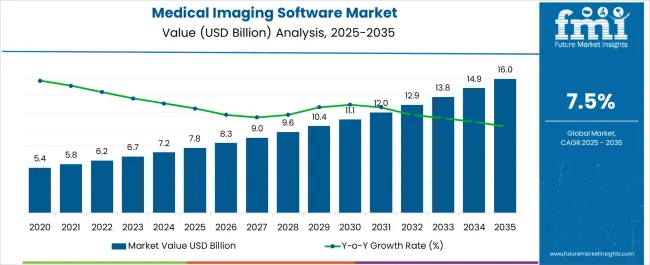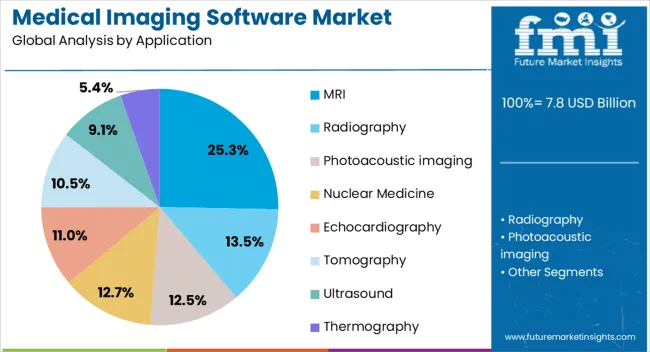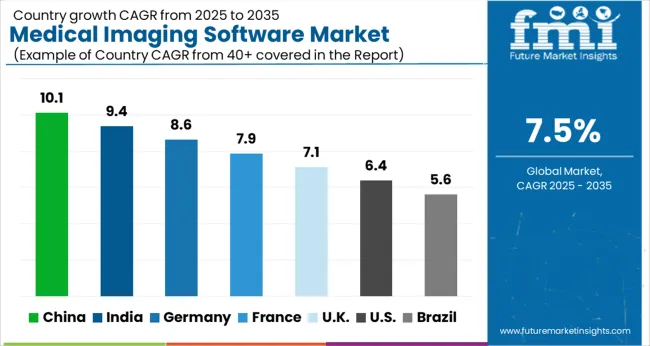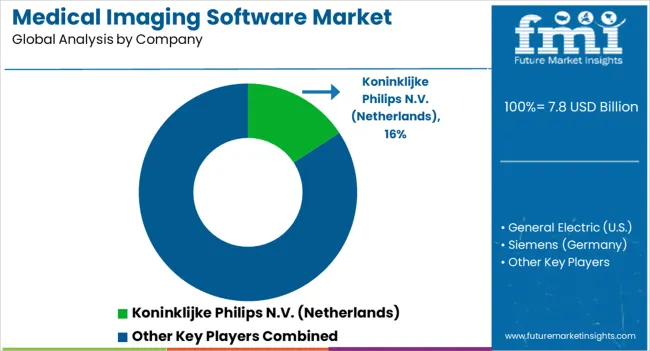The Medical Imaging Software Market is estimated to be valued at USD 7.8 billion in 2025 and is projected to reach USD 16.0 billion by 2035, registering a compound annual growth rate (CAGR) of 7.5% over the forecast period.

| Metric | Value |
|---|---|
| Medical Imaging Software Market Estimated Value in (2025 E) | USD 7.8 billion |
| Medical Imaging Software Market Forecast Value in (2035 F) | USD 16.0 billion |
| Forecast CAGR (2025 to 2035) | 7.5% |
The medical imaging software market is witnessing accelerated growth, driven by rising demand for advanced diagnostic solutions and the increasing prevalence of chronic diseases requiring accurate imaging. Hospitals, diagnostic centers, and specialty clinics are investing heavily in software platforms that enhance image acquisition, reconstruction, and analysis to improve diagnostic precision and patient outcomes. Technological advancements such as artificial intelligence, 3D visualization, and cloud-based imaging solutions are reshaping clinical workflows, enabling faster image interpretation and remote collaboration among healthcare professionals.
Growing emphasis on early disease detection and minimally invasive treatment planning is further supporting adoption across healthcare systems. Additionally, the integration of imaging software with electronic health records and hospital information systems is improving accessibility and data-driven decision-making.
Regulatory support for digital health adoption and reimbursement models favoring imaging-based diagnostics are also playing a significant role in shaping the market trajectory As healthcare systems increasingly prioritize efficiency, accuracy, and patient-centric care, the medical imaging software market is positioned for sustainable growth in both developed and emerging regions.
The medical imaging software market is segmented by application, and geographic regions. By application, medical imaging software market is divided into MRI, Radiography, Photoacoustic imaging, Nuclear Medicine, Echocardiography, Tomography, Ultrasound, and Thermography. Regionally, the medical imaging software industry is classified into North America, Latin America, Western Europe, Eastern Europe, Balkan & Baltic Countries, Russia & Belarus, Central Asia, East Asia, South Asia & Pacific, and the Middle East & Africa.

The MRI application segment is projected to hold 25.3% of the medical imaging software market revenue share in 2025, making it the leading application area. This leadership is being reinforced by the increasing utilization of MRI in the diagnosis of neurological, musculoskeletal, and cardiovascular disorders where precise visualization is critical. The segment is benefiting from advancements in imaging software that enhance resolution, reduce noise, and enable automated quantification, thereby improving the accuracy and efficiency of MRI examinations.
Rising demand for non-invasive and radiation-free diagnostic methods is further supporting the growth of MRI-based software solutions. Healthcare providers are increasingly adopting platforms that incorporate artificial intelligence and machine learning algorithms to assist in faster detection of abnormalities and streamlined workflow integration.
The ability of software-driven MRI applications to support multi-parametric imaging and functional studies is also expanding their clinical use As patient volumes rise and healthcare systems prioritize early detection and personalized care, MRI software is expected to remain a cornerstone application, securing its dominant position in the medical imaging software market.
Medical imaging software supports in the picturing of the tissues, organs or other body parts for medical diagnosis, treatment and disease supervision. Imaging methods include the fields of magnetic resonance, nuclear medicine, radiography, ocular imaging and other image guided intervention.
It aids in processing and forming pictorial representations of the internal parts of body for medical investigation, also to study physiology. They are applicable in wide areas of medical image visualization, computer aided surgical planning, computer added intervention, medical image visualization, molecular imaging etc.
Medical imaging software are used for the advancement of patient care and improved operating productivity by empowering doctors and other healthcare professionals with ease of handling and greater flexibility.
The medical imaging software market is growing with increase in demand for technically advanced market for imaging devices. Rapid technological innovations has derived a lot of changes in clinical diagnosis, treatment and disease monitoring.
Medical imaging software global market is driven by the scientific improvement in healthcare segment, escalation in number of medical imaging devices around the world. Also there are some factors for the growth of medical imaging software global market such as rise in the number of diagnostic centers, increase in the aging population and growth in incidence and prevalence of chronic disease.
Though, high cost related with clinical validation act as a major barrier for medical imaging software global market.
Due to fast technological development, increase in number of diagnostic centers, increase in the elderly population, increasing demand for better result, increase in the incidence and prevalence of disease, and increase in the number of clinical diagnosis around the globe, the medical imaging software global market is expected to have a healthy growth rate in the forecast period.
Depending on geographic regions, global medical Imaging software market is segmented into seven key regions: North America, Latin America, Eastern Europe, Western Europe, Asia Pacific Excluding Japan, Japan and Middle East & Africa.
North America is the leading market for medical imaging softwaredue to rapid technological innovations, huge investment on research and development in this region. Whereas, Europe and Asia-Pacific is projected to grow at a significant growth owing to large consumer base, rising administration initiatives for enhancing healthcare infrastructure will contribute to the global medical imaging software global market value exhibiting a robust CAGR during the forecast period, 2025-2026.
The report is a compilation of first-hand information, qualitative and quantitative assessment by industry analysts, inputs from industry experts and industry participants across the value chain. The report provides in-depth analysis of parent market trends, macro-economic indicators and governing factors along with market attractiveness as per segments. The report also maps the qualitative impact of various market factors on market segments and geographies.

| Country | CAGR |
|---|---|
| China | 10.1% |
| India | 9.4% |
| Germany | 8.6% |
| France | 7.9% |
| UK | 7.1% |
| USA | 6.4% |
| Brazil | 5.6% |
The Medical Imaging Software Market is expected to register a CAGR of 7.5% during the forecast period, exhibiting varied country level momentum. China leads with the highest CAGR of 10.1%, followed by India at 9.4%. Developed markets such as Germany, France, and the UK continue to expand steadily, while the USA is likely to grow at consistent rates. Brazil posts the lowest CAGR at 5.6%, yet still underscores a broadly positive trajectory for the global Medical Imaging Software Market. In 2024, Germany held a dominant revenue in the Western Europe market and is expected to grow with a CAGR of 8.6%. The USA Medical Imaging Software Market is estimated to be valued at USD 2.8 billion in 2025 and is anticipated to reach a valuation of USD 5.1 billion by 2035. Sales are projected to rise at a CAGR of 6.4% over the forecast period between 2025 and 2035. While Japan and South Korea markets are estimated to be valued at USD 353.0 million and USD 265.1 million respectively in 2025.

| Item | Value |
|---|---|
| Quantitative Units | USD 7.8 Billion |
| Application | MRI, Radiography, Photoacoustic imaging, Nuclear Medicine, Echocardiography, Tomography, Ultrasound, and Thermography |
| Regions Covered | North America, Europe, Asia-Pacific, Latin America, Middle East & Africa |
| Country Covered | United States, Canada, Germany, France, United Kingdom, China, Japan, India, Brazil, South Africa |
| Key Companies Profiled | Koninklijke Philips N.V. (Netherlands), General Electric (USA), Siemens (Germany), Hologic Inc. (USA), Sonic Healthcare Limited (Australia), Shimadzu Corporation (Japan), RadNet, Inc. (USA), Akumin Inc. (USA), RamSoft, Inc. (Canada), InHealth Group (UK), and Radiology Reports online (USA) |
The global medical imaging software market is estimated to be valued at USD 7.8 billion in 2025.
The market size for the medical imaging software market is projected to reach USD 16.0 billion by 2035.
The medical imaging software market is expected to grow at a 7.5% CAGR between 2025 and 2035.
The key product types in medical imaging software market are mri, radiography, photoacoustic imaging, nuclear medicine, echocardiography, tomography, ultrasound and thermography.
In terms of , segment to command 0.0% share in the medical imaging software market in 2025.






Our Research Products

The "Full Research Suite" delivers actionable market intel, deep dives on markets or technologies, so clients act faster, cut risk, and unlock growth.

The Leaderboard benchmarks and ranks top vendors, classifying them as Established Leaders, Leading Challengers, or Disruptors & Challengers.

Locates where complements amplify value and substitutes erode it, forecasting net impact by horizon

We deliver granular, decision-grade intel: market sizing, 5-year forecasts, pricing, adoption, usage, revenue, and operational KPIs—plus competitor tracking, regulation, and value chains—across 60 countries broadly.

Spot the shifts before they hit your P&L. We track inflection points, adoption curves, pricing moves, and ecosystem plays to show where demand is heading, why it is changing, and what to do next across high-growth markets and disruptive tech

Real-time reads of user behavior. We track shifting priorities, perceptions of today’s and next-gen services, and provider experience, then pace how fast tech moves from trial to adoption, blending buyer, consumer, and channel inputs with social signals (#WhySwitch, #UX).

Partner with our analyst team to build a custom report designed around your business priorities. From analysing market trends to assessing competitors or crafting bespoke datasets, we tailor insights to your needs.
Supplier Intelligence
Discovery & Profiling
Capacity & Footprint
Performance & Risk
Compliance & Governance
Commercial Readiness
Who Supplies Whom
Scorecards & Shortlists
Playbooks & Docs
Category Intelligence
Definition & Scope
Demand & Use Cases
Cost Drivers
Market Structure
Supply Chain Map
Trade & Policy
Operating Norms
Deliverables
Buyer Intelligence
Account Basics
Spend & Scope
Procurement Model
Vendor Requirements
Terms & Policies
Entry Strategy
Pain Points & Triggers
Outputs
Pricing Analysis
Benchmarks
Trends
Should-Cost
Indexation
Landed Cost
Commercial Terms
Deliverables
Brand Analysis
Positioning & Value Prop
Share & Presence
Customer Evidence
Go-to-Market
Digital & Reputation
Compliance & Trust
KPIs & Gaps
Outputs
Full Research Suite comprises of:
Market outlook & trends analysis
Interviews & case studies
Strategic recommendations
Vendor profiles & capabilities analysis
5-year forecasts
8 regions and 60+ country-level data splits
Market segment data splits
12 months of continuous data updates
DELIVERED AS:
PDF EXCEL ONLINE
Medical Silicone Radiopaque Vascular Ties Market Size and Share Forecast Outlook 2025 to 2035
Medical Indoor Air Purifier Market Size and Share Forecast Outlook 2025 to 2035
Medical Eye Shield Film Market Size and Share Forecast Outlook 2025 to 2035
Medical Far Infrared Therapy Device Market Size and Share Forecast Outlook 2025 to 2035
Medical Latex Protective Suit Market Size and Share Forecast Outlook 2025 to 2035
Medical Activated Carbon Dressing Market Size and Share Forecast Outlook 2025 to 2035
Medical Coated Roll Stock Market Size and Share Forecast Outlook 2025 to 2035
Medical Billing Outsourcing Market Size and Share Forecast Outlook 2025 to 2035
Medical Pressure Mapping System Market Size and Share Forecast Outlook 2025 to 2035
Medical Chairs Market Size and Share Forecast Outlook 2025 to 2035
Medical Exoskeleton Market Forecast Outlook 2025 to 2035
Medical Display Market Forecast and Outlook 2025 to 2035
Medical Spa Market Size and Share Forecast Outlook 2025 to 2035
Medical Face Shield Market Forecast and Outlook 2025 to 2035
Medical Robot Market Size and Share Forecast Outlook 2025 to 2035
Medical Nutrition Market Forecast and Outlook 2025 to 2035
Medical Wax Market Size and Share Forecast Outlook 2025 to 2035
Medical Specialty Bag Market Size and Share Forecast Outlook 2025 to 2035
Medical Plastics Market Size and Share Forecast Outlook 2025 to 2035
Medical Device Tester Market Size and Share Forecast Outlook 2025 to 2035

Thank you!
You will receive an email from our Business Development Manager. Please be sure to check your SPAM/JUNK folder too.
Chat With
MaRIA